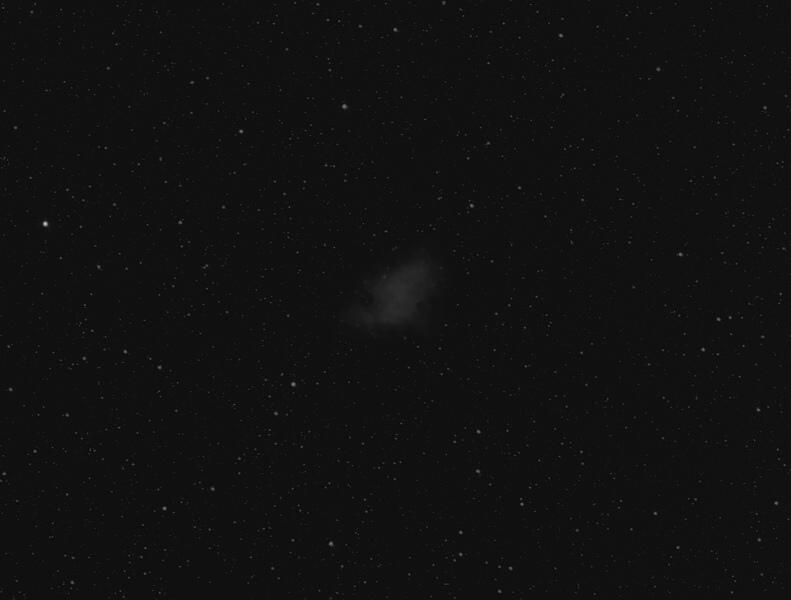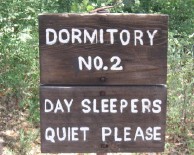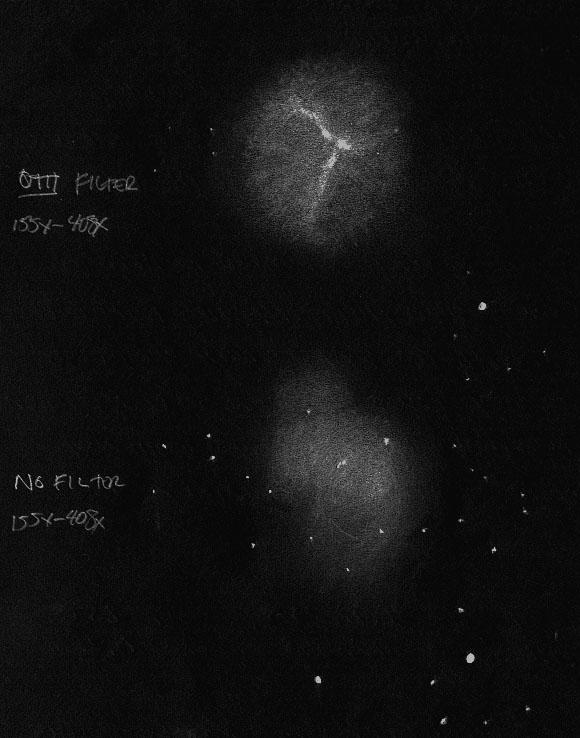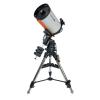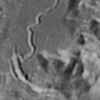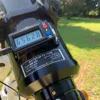
Lack of detail in M1
#1

Posted 02 December 2011 - 10:42 AM
I have tried various magnifications, ranging from 50X to 175X, but have been unable to make out any detail. At low powers, M1 appears as a nondescript gray haze, with the area immediately surrounding it apparently void of stars. At higher powers, the image dims significantly.
Should I be seeing more, or is this fairly typical?
#2

Posted 02 December 2011 - 12:27 PM
M1 Drawing
Tom
#3

Posted 02 December 2011 - 12:40 PM
Will
#4

Posted 02 December 2011 - 12:50 PM
#5

Posted 02 December 2011 - 01:00 PM
... Apparently it was lifted from Astronomy Sketch of the Day, but I could find out from that site who drew it.
M1 Drawing
Tom
Tom,
I think his name is Michale Vlasov of Israel. He goes by Michael11 here on Cloudy Nights. He really does good work with his 8-inch dob and posts here too.
#6

Posted 02 December 2011 - 02:47 PM
My most recent posted log has the same description Buddy just gave. I see a peanut or notched oblong shape in my 8 inch. Someone else also said their Orion 14XTi shows about the same thing. Only I bet its brighter.
I've never gotten improvement with either of my Nebulae filters.
Clear Skies,
Matt
#7

Posted 02 December 2011 - 03:24 PM
#8

Posted 02 December 2011 - 06:45 PM
18" (11/14/09): at 175x and OIII filter an obvious brighter filament is visible that begins just south of center and extends WNW towards the west end. This filament is brightest (or has a brighter knot) at its eastern end near the center. A fainter filament begins near the same point south of center and extends towards the NE. The two filaments, if joined as one, extend nearly from the west end of the Crab Nebula to the east.
#9

Posted 02 December 2011 - 09:42 PM
#10

Posted 02 December 2011 - 10:37 PM
When I've tried an O-III, it has practically destroyed the image so I generally don't use the filter. A UHC has helped in the past (a little bit). This is one nebula where, to me at least, the O-III doesn't help much. Steve, I'm surprised you were able to use it with such good results.
I would suggest trying the O-III again. It will mute the overall brightness of the Crab, but the *internal* filaments do stand out better. Magnification is certainly important also, so try higher powers if the seeing allows. But the OIII filter and dark skies is the ticket to see the filaments.
#11

Posted 03 December 2011 - 01:27 AM
Next time... Thanks.
#13

Posted 03 December 2011 - 03:46 AM
My experience are that you need 12" + [OIII] at minimum to see the brightest filaments. With 16" it should be no problem.
With 27", 366x and [OIII] the Crab dissolve in endless structure which can be sketched only with problems. Superb object!

to homepage with invert version (Java on)
uwe
#14

Posted 03 December 2011 - 05:07 AM
My one-shot-colour pic from last week - the tiny star abutting the 'double-star' immediately north/above neb = mag18.2 :o Below is a channel split of the main image into red/green/blue and may be a guide to visual obs. Here's a close crop showing M1 pulsar
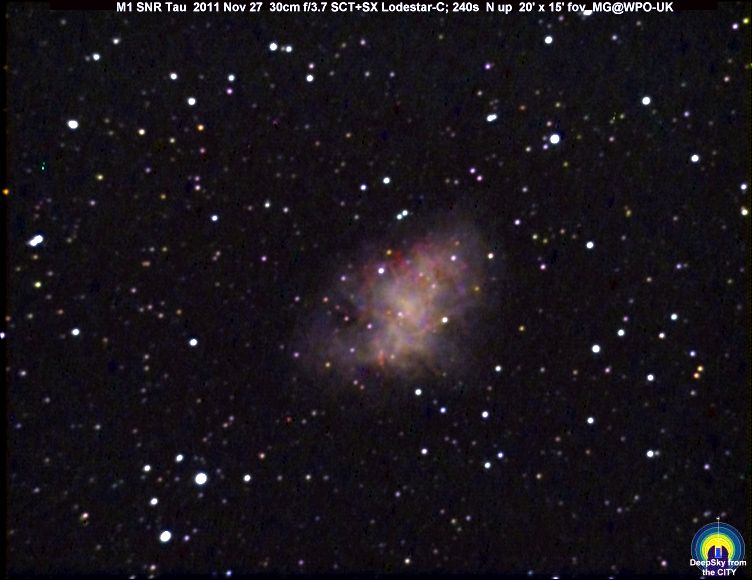
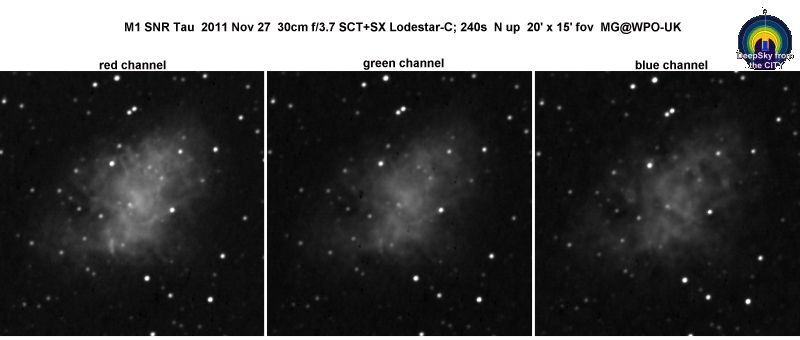
#15

Posted 03 December 2011 - 07:41 PM
David's sketch comes the closest to my own view of this object a couple of weeks ago.
Nice work..
An interesting object, but not spectalur to view. Except if you know its history, than it shines.
Clear Skies,
Matt
#16

Posted 04 December 2011 - 09:55 PM
#17

Posted 05 December 2011 - 10:47 AM
#18

Posted 05 December 2011 - 04:40 PM
After flipping back and forth being unfiltered and OIII views I decided to sketch both to show the difference - at least to my eyes through my scope. This isn't the most detailed view I've ever had of M1 but it was pretty good. I used 250x to 400x for both sketches. They barely look like the same object as there are no hints of the filaments without a filter and the shape/orientation of the overall shape seems different. The main body of M1 has a mottled texture with the OIII but is very smooth looking in the unfiltered view. I had a sense that a bunch of fainter filaments were just barely unseen and if the sky was darker/more transparent/steadier they might start coming into view. The perimeter of the OIII view seemed ragged while it was smooth without.
Anyway, just another perspective on this fascinating object.
#19

Posted 05 December 2011 - 08:17 PM
Clear skies,
Brandon Doyle
#20

Posted 05 December 2011 - 08:43 PM
#21

Posted 08 December 2011 - 07:42 PM
The second sketch definitely says it all for the Crab in my 8 inch without filters.
Clear Skies,
Matt
#22

Posted 09 December 2011 - 01:05 AM
Any one ever try for the Crab Pulsar (PSR B0531+21) ??
#23

Posted 09 December 2011 - 05:13 AM
What's the smallest aperture that is required to see the Crab pulsar?
Have you managed to do it with the 48"!
#24

Posted 09 December 2011 - 11:11 AM
#25

Posted 09 December 2011 - 12:56 PM











